Understanding home monitoring and self-management in breast cancer-related lymphoedema: a qualitative study
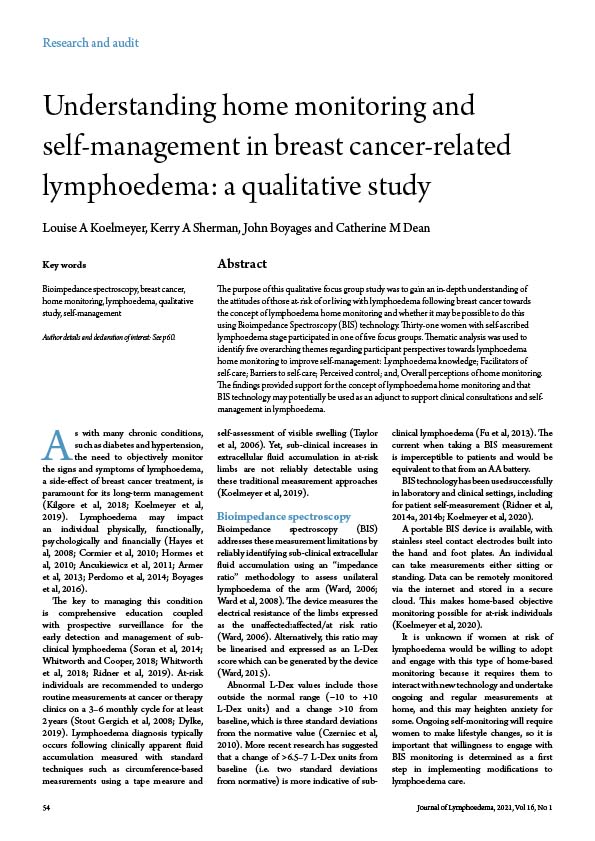
The purpose of this qualitative focus group study was to gain an in-depth understanding of the attitudes of those at-risk of or living with lymphoedema following breast cancer towards the concept of lymphoedema home monitoring and whether it may be possible to do this using Bioimpedance Spectroscopy (BIS) technology. Thirty-one women with self-ascribed lymphoedema stage […]
Timely management of a primary lower-limb lymphoedema through the combination of the complete decongestive therapy and the pneumatic compression device: a 4-day treatment

Background: This case study concerns a 44-year-old man who suffered from primary lymphoedema in the left lower limb. This particular patient visited the author’s centre to receive treatment for the lower limb. However, immediately after the start of the sessions, an emergent professional obligation forced him to go abroad immediately for a month. This development […]
Cancer, breast cancer-related lymphoedema and other fears: the emerging story

I know everyone’s experience of cancer is different. However, I believe it’s important to hear as many of them as we can since they all add something significant to our knowledge, our ability to question and our comfort with the responses and outcomes, as well as to allay rather than potentiate fears that some may […]
Exufiber® and Exufiber® Ag+: A review of the scientific and clinical evidence

Wound dressings have been created to manage a number of clinical conditions, including cavity wounds and wounds where exudate levels may vary from low levels in a relatively dry wound to highly exuding wounds where there is a genuine risk of damage to the surrounding skin. The evidence included in this supplement highlights some of […]
Biotechnological innovations: role of a reactive oxygen species release device in the management of pilonidal cysts

The pilonidal cyst usually manifests by the formation of ulcers or orifices in the sacrococcygeal region. It generally affects young males aged 15–30 (Mohamadi et al, 2019), has a reported incidence rate of 26/10,000 people and affects men 2.2 times more than women (Nixon and Garza, 2020). Improper cleaning of the wound bed can slow […]
Promising results in wound care with a new rapid capillary action dressing: a case series study

This case series aimed to describe treatment effects and experiences of patients who switched from negative pressure wound therapy (NPWT) to a rapid capillary action dressing (RCAD; VACUTEX™). Ten consecutive patients who prematurely terminated NPWT were recruited. Mean time to complete wound closure was 87.3 days (SD 38.3). The main reasons for terminating NPWT were […]
Early experience with a novel aerosol formula of silver sulfadiazine, lidocaine, and vitamin A in the treatment of scalp pressure ulcers
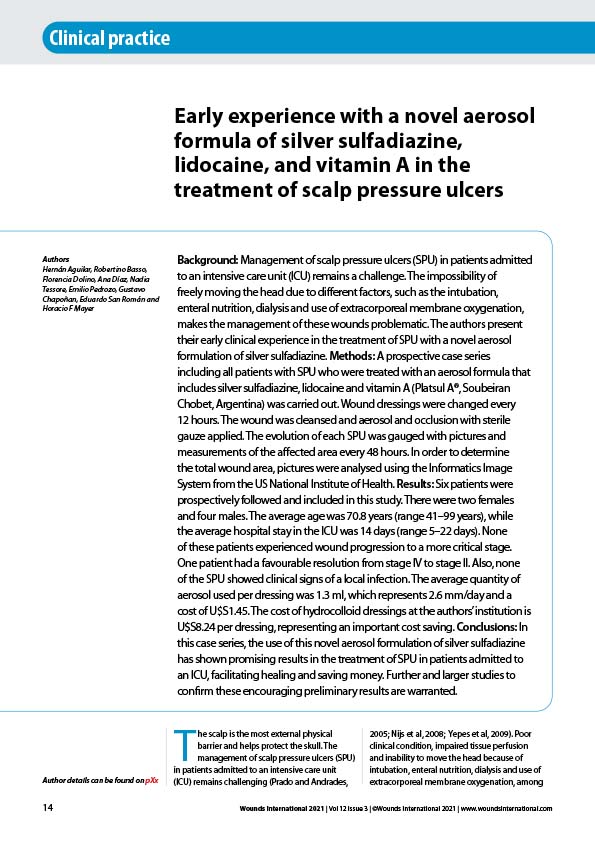
Background: Management of scalp pressure ulcers (SPU) in patients admitted to an intensive care unit (ICU) remains a challenge. The impossibility of freely moving the head due to different factors, such as the intubation, enteral nutrition, dialysis and use of extracorporeal membrane oxygenation, makes the management of these wounds problematic. The authors present their early […]
Using the diabetic foot ulcer aetiologyspecific T.I.M.E. clinical decision support tool to promote consistent holistic wound management and eliminate variation in practice

The T.I.M.E. clinical decision support tool (CDST) (Moore et al, 2019; World Union of Wound Healing Societies, 2020) is based on the well-established T.I.M.E. wound bed preparation framework (Schultz et al, 2003). The tool has been further developed to help support clinicians decide the treatment plan for different wound aetiologies – namely venous leg ulcers, […]
Using the venous leg ulcer aetiologyspecific T.I.M.E. clinical decision support tool to promote consistent holistic wound management and eliminate variation in practice

The T.I.M.E. clinical decision support tool (CDST; Moore et al, 2019; World Union of Wound Healing Societies, 2020) is based on the well-established T.I.M.E. wound bed preparation framework (Schultz et al, 2003). The tool has been further developed to help support clinicians to assess different wound types – namely venous leg ulcers (VLUs), pressure ulcers/injuries, […]
Clinical evaluation of UrgoClean Ag (poly-absorbent dressing based on technology lipido-colloid with silver ions) in the management of infected wounds in Asia

Wound infections, including biofilms play a significant role in delaying wound healing and are considered to be one of the major challenges in wound management. The presence of non-viable tissue, such as slough, is a prominent feature of chronic wounds and is considered as a barrier against successful wound healing. A key component in wound […]
Post-surgical incision care across the Asia-Pacific region: current practice and perceptions

Background and Aims: Post-surgical incision care is a critical component in optimising patient outcomes and has the potential to reduce the risk of infection and associated complications. Dressing characteristics, selection and change frequency are important aspects of achieving good outcomes. The aims of this study were to gain insights into the current practice of post-surgical […]
A silver alginate paste dressing in the management of non-malignant wounds with signs of infection in oncology patients: an observational prospective case series

Oncology patients have a higher risk of developing wound complications associated with procedures and agents used for cancer treatment. This observational case series investigated the clinical benefits of a silver alginate paste dressing in the management of stalled or deteriorating non-malignant wounds showing clinical signs of local infection or considered at high risk of infection […]
A tool to promote patient and informal carer involvement for shared wound care

Shared wound care encompasses approaches and interventions that enable patients to participate in care planning and delivery, rather than just being a passive recipient of services provided. A key step in facilitating greater shared care is identifying the individuals (patients and informal carers) who would be good candidates to be involved in shared wound care. […]
Access to information regarding management of pressure injuries in South Africa during the COVID-19 pandemic: A nurse’s perspective

Worldwide, nurses were faced with a major influx of COVID-19 patients in 2020. South Africa was not spared from this surge. As a South African nurse, I experienced first-hand that not only did nurses have to suddenly care for an incursion of patients’ diagnoses with a novel virus, but consequently had to also deal with […]
Residual pressure ulcers in COVID-19 patients

You have likely heard of post- COVID conditions. There are many terms for the wide range of health consequences that are present 4 or more weeks after infection with COVID-19. Some of the best known are ‘COVID brain’ to describe cloudy thinking and ‘long-hauler syndrome’ to describe fatigue and residual pulmonary issues. However, I would […]
Ten top tips: skin grafting

Skin grafting is a common method of surgical wound closure. Partial (split) and full-thickness skin grafts are the two main categories of skin grafting, each with their pros and cons. Generally, skin grafting is used when other methods of reconstruction such as primary closure, second-intention healing, or local skin flaps are inappropriate, unavailable, or would […]
Moisture-associated skin damage in an intensive care unit setting

In an Intensive care unit (ICU) the focus is mainly on keeping people alive. That is the most important perspective. At the same time, some patients stay in ICU for a long time and other nursing-related problems must be solved during their stay. Moisture-associated skin damage (MASD) is a group of skin problems that may […]
Wounds digest

In this section, a brief synopsis is presented of a range of recently published articles that may be of interest to healthcare professionals working in the wound care setting. The aim of this round-up is to provide an overview, rather than a detailed summary and critique, of the research papers selected. Full references are provided […]
The Wound Care Pathway – an evidence-based and step-by-step approach towards wound healing

Chronic wounds are challenging for patients to live with, complex for healthcare professionals to manage and expensive for society to treat. A group of wound care experts developed a practical and evidence-based clinical pathway for managing chronic wounds. Utilising a modified Delphi process, this consensus-based project involved nearly 2,500 frontline healthcare professionals across six continents. […]
Quick Guide: 3M™ Kerracontact™ Ag Dressing in pratice

This Quick Guide provides a comprehensive treatment pathway for recognising and treating symptoms of infection using 3M™ KerraContact™ Ag with Ag Oxysalts™ Technology.
Quick Guide: The Infection Management Pathway

This Quick Guide outlines the Infection Management pathway from Smith+Nephew, A route to more effective infection management
Quick Guide: Using 3M™ Veraflo™ Therapy

This Quick Guide outlines treatment pathway for using 3M™ Veraflo™ Therapy, a product that combines the benefits of negative pressure wound therapy (NPWT) with other 3M™ dressings.
Best Practice Recommendations for Prevention and Management of Periwound Skin Complications

Periwound management is an important but sometimes overlooked area, despite the impact it has on wound bed preparation and wound healing. Periwound breakdown delays wound healing and increases pain. It is imperative that conditions and risk factors are identified early to prevent the risk of wound progress declination. There has been confusion around definitions of […]
Closed but not healed
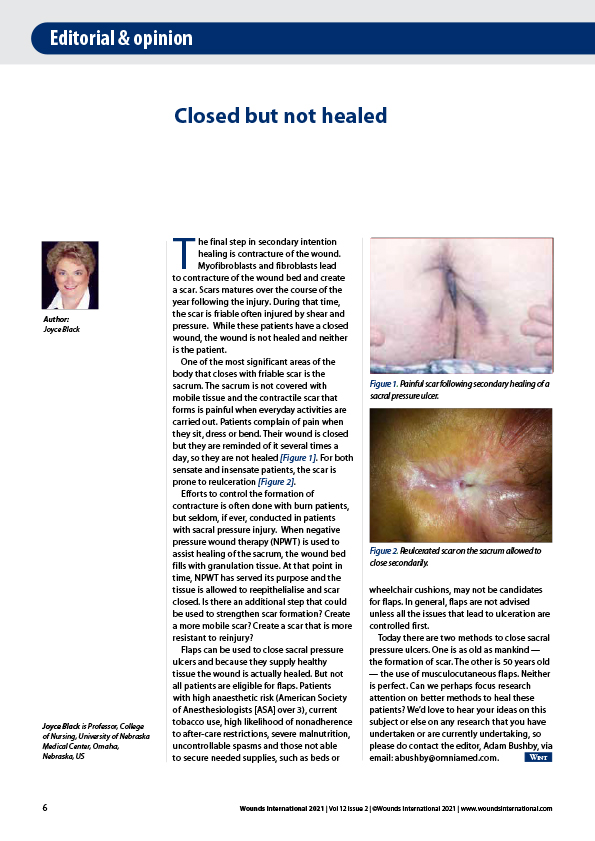
The final step in secondary intention healing is contracture of the wound. Myofibroblasts and fibroblasts lead to contracture of the wound bed and create a scar. Scars matures over the course of the year following the injury. During that time, the scar is friable often injured by shear and pressure. While these patients have a […]
Ten top tips: mitigating deep tissue pressure injury

Deep tissue pressure injury (DTPI) was first identified as a type of pressure ulcer 20 years ago (Black, 2003). The US National Pressure Injury Advisory Panel started to formally study DTPI a few years later (Ankrom et al, 2005). While it might be believed that DTPI is an atypical pressure injury compared with the counterparts […]
Early COVID-19 and the experiences of Canadian wound care clinicians: preliminary findings

These preliminary data are part of a larger qualitative study designed to explore the experiences and learnings of frontline wound care clinicians in Canada during the COVID-19 pandemic. This body of work may influence further research and the development of wound-related policies. Individuals on Wounds Canada’s mailing list were invited to describe their experiences in […]
Saturation of a dressing applied to an exuding wound: the gap between clinical judgment and laboratory testing

It is well established that a moist, but not wet, wound bed is conducive to healing. However, evaluating the ability of a dressing to induce such conditions in the wound bed, while also preventing leakage and minimising maceration of the periwound skin, remains a challenge. Clinical measurements of the fluid handling performances of wound dressing […]
Understanding normal seasonal variations in upper-limb size, volume and fluid distribution in a healthy female population: a North Queensland study

This study set out to determine whether or not variations in upper limb arm size, volume or fluid distribution occur in response to heat and humidity, as it varies with the seasons in healthy females. Data collection took place in spring, summer and winter, with results showing a significant relationship between seasonal climate variation and […]
The efficacy of closed incision negative pressure wound therapy to reduce surgical site infections: a systematic review

Background: Surgical site infection (SSI) is a global concern and a critical threat to surgical outcomes. Despite the incorporation of evidence-based SSI care bundles worldwide, the incidence and associated morbidity and mortality rates of SSIs remain considerable (Strugala and Leaper, 2018). Closed incision Negative Pressure Wound Therapy (ciNPWT) is designed to mitigate against the occurrence […]
An observational pilot study to collect safety and efficacy data on wound care using whole blood clot technology on hard-to-heal wounds

This multi-centre observational pilot study explored the use of whole blood clot (WBC) therapy on hard-to-heal wounds where the phases of wound healing have been interrupted or stalled. Primary data from 29 patients were gathered from 10 pilot sites in South Africa and Israel. Prior to the application of WBC as an advanced technology, several […]
3D-printed wound chambers: a novel splint system for wound healing research

Healing in humans is driven by re-epithelialisation and granulation tissue formation. We know that rodents heal primarily through strong skin contraction (Chen et al, 2015), complicating its clinical translatability as a wound model. Splint systems have attempted to minimise wound contraction, but are associated with severe limitations, such as frailty, the inability to retain liquids, […]
Auto-amputation: a case study from Lucknow, India

In this case study, the author shares a real-world story, in which the treatment of a patient with diabetic foot was interrupted by the COVID-19 pandemic-related lockdown. Since surgery could not be planned due to lockdown, the author chose to wait for auto-amputation to happen, as a primary management strategy. Auto-amputation is the self-detachment of […]
Topical oxygen therapy used to improve wound healing in a large retrospective study of wounds of mixed aetiology

Chronic wounds are one of the most prevalent and costly conditions in developed countries and are a heavy burden on patient quality of life. Treating the underlying metabolic demands of tissue can help wound healing, including delivering supplemental oxygen to hypoxic wound tissue. In this large 200-patient retrospective study, it is demonstrated that topically administered […]
Clinician expectations in wound care during the COVID-19 pandemic: March 2020 to January 2021

A group of 18 European wound care specialists were surveyed in March 2020 on the expected impact of the COVID-19 pandemic on wound care and their clinical practice. The panel expected inadequate wound diagnosis, delays in treatment, increased wound infection and inflammation and increased patient hospitalisations as a result of national lockdowns and redeployment of […]
Wounds digest 12-2

In this section, a brief synopsis is presented of a range of recently published articles that may be of interest to healthcare professionals working in the wound care setting. The aim of this round-up is to provide an overview, rather than a detailed summary and critique, of the research papers selected. Full references are provided […]
Unique times call for unique measures

A wise man once said that “desperate times call for desperate measures”. While I couldn’t find attribution for this quote, it was allegedly the Greek physician Hippocrates who uttered the words “for extreme diseases, extreme methods of cure, as to restriction, are most suitable” in around 400BC (The Internet Classics Archive, 2009) and is where […]
3M™ Snap™ Therapy System

This Quick Guide outlines the 3M™ Snap™ Therapy System, a wearable device that combines the benefits of negative pressure wound therapy (NPWT) with advanced wound dressings. Supported by 3M
Made Easy: HydroClean©

If not appropriately managed, every wound has the potential to develop serious complications such as infection, and to become hard-to-heal (WUWHS, 2020). There is a clear need for a first-line dressing that can be used with confidence in a variety of different wound types and address potential factors that may develop and affect wound healing. […]
Made Easy: Medical device protection

The COVID-19 pandemic has increased focus on the consequences of pressure and skin damage, through patients being in bed or immobile for extended periods of time, particularly when nursed in the prone position, or through use of medical devices such as face masks. In protecting patients from ARDS (acute respiratory distress syndrome) and VAP (ventilator-associated […]
Medical device-related pressure ulcers — a call to action

In 2010, the automobile manufacturer, Toyota, had received over 100 complaints about brake problems. When the brakes failed on a car in California and lead to the death of four people, Toyota recalled over 2.5 million cars to have them inspected and repaired. Over the next 4 months, the company recalled 3.4 million more vehicles […]
Ten top tips: honing your pressure injury risk assessment
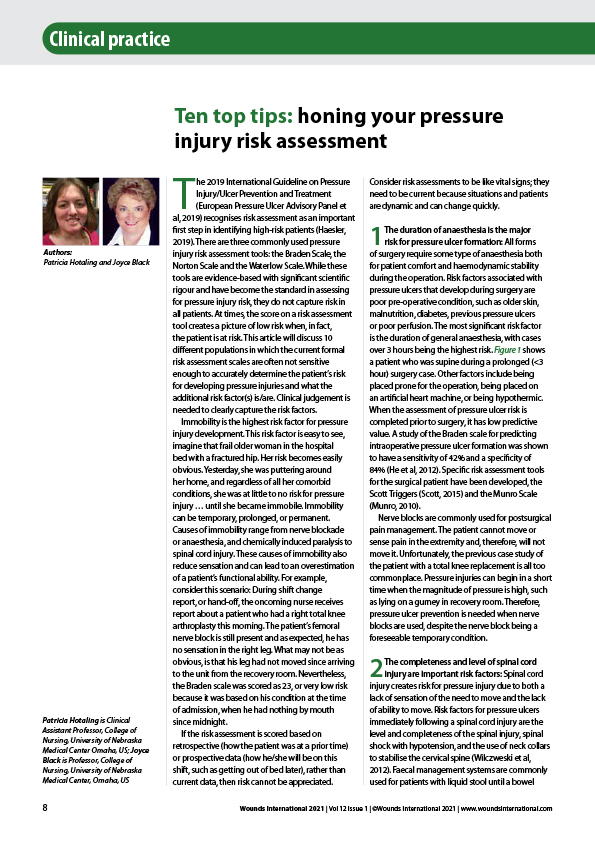
The 2019 International Guideline on Pressure Injury/Ulcer Prevention and Treatment (European Pressure Ulcer Advisory Panel et al, 2019) recognises risk assessment as an important first step in identifying high-risk patients (Haesler, 2019). There are three commonly used pressure injury risk assessment tools: the Braden Scale, the Norton Scale and the Waterlow Scale. While these tools […]
Living with chronic wounds: an exploration of adaptive and maladaptive coping strategies and their association with wellbeing
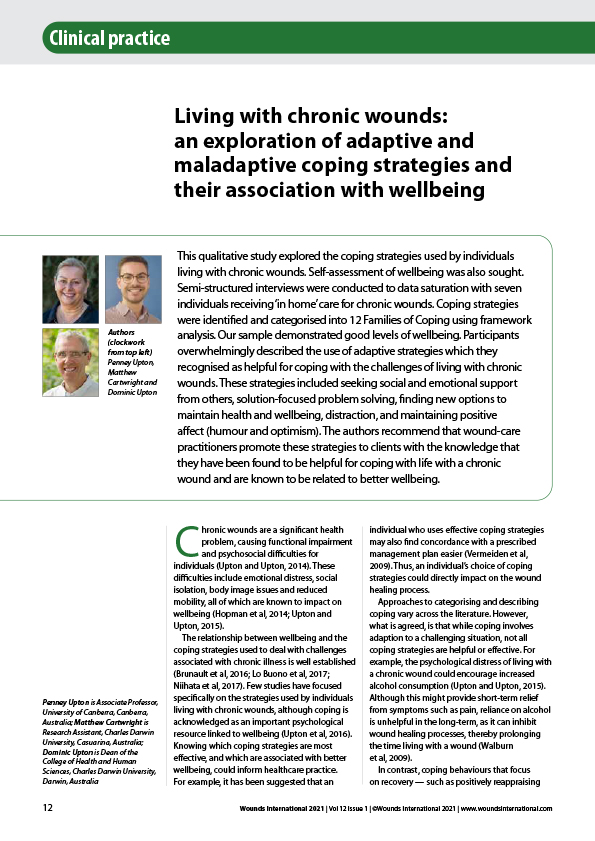
This qualitative study explored the coping strategies used by individuals living with chronic wounds. Self-assessment of wellbeing was also sought. Semi-structured interviews were conducted to data saturation with seven individuals receiving ‘in home’ care for chronic wounds. Coping strategies were identified and categorised into 12 Families of Coping using framework analysis. Our sample demonstrated good […]
The role of the thermal conductivity of dressings in prevention and treatment of wounds

The thermal conductivity of dressing materials and structures is a fundamental physical property of high clinical relevance in both prevention and treatment of acute and chronic wounds. The thermal conductivity measurement of a dressing expresses the extent of metabolic heat transfer from the tissues under the dressing, outward through the dressing structure. This value can […]
Barriers and enablers for effective implementation of the TIME framework for chronic wounds in a district nursing service

This study aimed to identify gaps in practice, through data collection over a period of 4 years at several district nurse services and to explore the perceived barriers and enablers to implementing the TIME framework when assessing and managing chronic wounds. The data collected ignited a change in wound care practice in the West Hume […]
The prevalence and treatment of oedema at the end of life: a retrospective review of 400 cases

Oedema at the end of life (OATEOL) is common and causes functional disability and psychological distress. The purpose of this study was to estimate the prevalence of OATEOL in a palliative care population and document the treatment options being offered. A retrospective case note review of 400 patients was conducted by the authors. Of the […]
Non-healing wound from disseminated blastomycosis
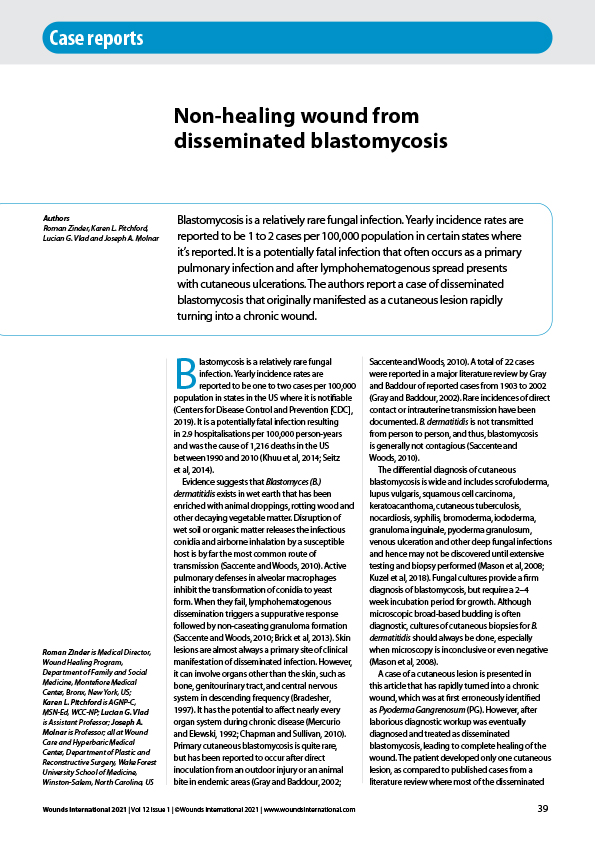
Blastomycosis is a relatively rare fungal infection. Yearly incidence rates are reported to be 1 to 2 cases per 100,000 population in certain states where it’s reported. It is a potentially fatal infection that often occurs as a primary pulmonary infection and after lymphohematogenous spread presents with cutaneous ulcerations. The authors report a case of […]
Second degree burn treated with Curefini™ ointment and PVC film: an accessible wound care strategy in developing countries

Finding accessible and affordable natural products that are medically tested treatment options for domestic burns must be a priority for developing countries. This should be accompanied by educational first aid strategies. This paper discusses the benefits of Curefini™ (Pure Source) ointment for burns. Curefini contains polyunsaturated fatty acids and beeswax with anti-inflammatory and tissue repair […]
Clinician attitudes to shared-care and perceptions on the current extent of patient engagement in wound care: Results of a clinician survey

Market research conducted in November and December 2020 presented in this article gives insight into how clinicians can be better equipped to support patients to self-care. Results show that clinicians in Australia, China, France, Germany, Spain, the UK and the USA, estimated that 45% of their patients with chronic wounds could benefit from greater involvement […]
Round table discussion: cellulose fluff dressings — a new dressing technology in pressure ulcer

Pressure ulcers (also called pressure injuries in the US, Canada and Australia) may develop from beneath the skin, can present themselves rapidly and cause skin and underlying tissue breakdown (European Pressure Ulcer Advisory Panel [EPUAP], National Pressure Injury Advisory Panel [NPIAP], and Pan Pacific Pressure Injury Alliance [PPPIA], 2019; Gefen et al, 2020a), leading to […]
Reconstruction of scalp defects with exposed bone using dermis template (Integra®) with or without autologous skin micrografts (Rigenera®) and Flowable wound matrix (Integra®)

Background: The aim of this study was to investigate the use of autologous micrografts obtained by the Rigenera Micrografting Technology, dermal substitute and flowable wound matrix (Integra®) on injuries involving the scalp with exposed skull. For large scalp wounds with exposed calvarium, drilling of the exposed bone followed by skin grafting is usually not successful, […]


